Cyclic Subcritical Water Injection into Bazhenov Oil Shale: Geochemical and Petrophysical Properties Evolution Due to Hydrothermal Exposure
Abstract
1. Introduction
2. Materials and Methods
2.1. Samples
2.2. Subcritical Water Injection
2.3. Rock-Eval Pyrolysis
2.4. Three-Dimensional X-ray Computed Microtomography
2.5. Elastic Properties
2.6. Product Analysis
3. Results and Discussion
3.1. Laboratory Investigation
3.2. Numerical Investigation: Optimization of the Kinetic Model
4. Conclusions
Author Contributions
Funding
Acknowledgments
Conflicts of Interest
References
- BP Statistical Review of World Energy. 2019. Available online: https://www.bp.com/content/dam/bp/business-sites/en/global/corporate/pdfs/energy-economics/statistical-review/bp-stats-review-2019-full-report.pdf (accessed on 16 May 2020).
- Speight, J.G. Synthetic Fuels Handbook: Properties, Process, and Performance; McGraw-Hill: New York, NY, USA, 2008; ISBN 9780071490238. Available online: https://www.amazon.com/Synthetic-Fuels-Handbook-Performance-McGraw-Hill/dp/007149023X (accessed on 30 June 2008).
- Markovic, S.; Bryan, J.L.; Turakhanov, A.; Cheremisin, A.; Mehta, S.A.; Kantzas, A. In-Situ Heavy Oil Viscosity Prediction at High Temperatures Using Low-Field NMR Relaxometry and Nonlinear Least Squares. Fuel 2020, 260, 116328. [Google Scholar] [CrossRef]
- EIA/ARI. World Shale Gas and Shale Oil Resource Assessment. 2013. Available online: https://www.eia.gov/analysis/studies/worldshalegas/pdf/overview.pdf (accessed on 16 May 2020).
- Tissot, B.P.; Welte, D.H.; Tissot, B.P.; Welte, D.H. Kerogen: Composition and Classification. In Petroleum Formation and Occurrence; Springer: Berlin/Heidelberg, Germany, 1984; pp. 131–159. [Google Scholar]
- Ryan, R.C.; Fowler, T.D.; Beer, G.L.; Nair, V. Shell’s In Situ Conversion Process−From Laboratory to Field Pilots. 2010, pp. 161–183. Available online: https://pubs.acs.org/doi/abs/10.1021/bk-2010-1032.ch009 (accessed on 16 May 2020).
- Symington, W.A.; Kaminsky, R.D.; Meurer, W.P.; Otten, G.A.; Thomas, M.M.; Yeakel, J.D. ExxonMobil’s Electrofrac TM Process for In Situ Oil Shale Conversion. 2010, pp. 185–216. Available online: https://pubs.acs.org/doi/abs/10.1021/bk-2010-1032.ch010 (accessed on 16 May 2020).
- Burnham, A.K.; Day, R.L.; Hardy, M.P.; Wallman, P.H. AMSO’s Novel Approach to In-Situ Oil Shale Recovery. 2010, pp. 149–160. Available online: https://pubs.acs.org/doi/abs/10.1021/bk-2010-1032.ch008 (accessed on 16 May 2020).
- Crawford, P.M.; Killen, J.C. New Challenges and Directions in Oil Shale Development Technologies; ACS Symposium Series; American Chemical Society: Washington, DC, USA, 2010; Volume 103, pp. 21–60. [Google Scholar] [CrossRef]
- Meijssen, T.E.M.; Emmen, J.; Fowler, T.D. In-Situ Oil Shale Development in Jordan through ICP Technology. In Proceedings of the Abu Dhabi International Petroleum Exhibition and Conference; Society of Petroleum Engineers, Abu Dhabi, UAE, 10–13 November 2014. [Google Scholar]
- Hascakir, B.; Babadagli, T.; Akin, S. Experimental and Numerical Simulation of Oil Recovery from Oil Shales by Electrical Heating. Energy Fuels 2008, 22, 3976–3985. [Google Scholar] [CrossRef]
- Gutierrez, D.; Taylor, A.R.; Kumar, V.; Ursenbach, M.G.; Moore, R.G.; Mehta, S.A. Recovery Factors in High-Pressure Air Injection Projects Revisited. SPE Soc. Pet. Eng. 2008, 11, 1097–1106. [Google Scholar] [CrossRef]
- Kokorev, V.I.; Darishchev, V.I.; Akhmadeishin, I.A.; Shchekoldin, K.A.; Boksernam, A.A. The Results of the Field Tests and Prospects of Termogas Development of Bazhenov Formation in OJSC RITEK. In Proceedings of the SPE Russian Oil and Gas Exploration & Production Technical Conference and Exhibition; Society of Petroleum Engineers, Moscow, Russia, 14–16 October 2014. [Google Scholar]
- Bauman, J.H.; Deo, M. Simulation of a Conceptualized Combined Pyrolysis, In Situ Combustion, and CO2 Storage Strategy for Fuel Production from Green River Oil Shale. Energy Fuels 2012, 26, 1731–1739. [Google Scholar] [CrossRef]
- Kar, T.; Hascakir, B. In-Situ Kerogen Extraction via Combustion and Pyrolysis. J. Pet. Sci. Eng. 2017, 154, 502–512. [Google Scholar] [CrossRef]
- Luong, D.; Sephton, M.A.; Watson, J.S. Subcritical Water Extraction of Organic Matter from Sedimentary Rocks. Anal. Chim. Acta 2015, 879, 48–57. [Google Scholar] [CrossRef] [PubMed]
- Siskin, M.; Katritzky, A.R. Reactivity of Organic Compounds in Superheated Water: General Background. Chem. Rev. 2001, 101, 825–836. [Google Scholar] [CrossRef] [PubMed]
- Thiruvenkadam, S.; Izhar, S.; Yoshida, H.; Danquah, M.K.; Harun, R. Process Application of Subcritical Water Extraction (SWE) for Algal Bio-Products and Biofuels Production. Appl. Energy 2015, 154, 815–828. [Google Scholar] [CrossRef]
- Kang, P.-S.; Lim, J.-S.; Huh, C. Screening Criteria and Considerations of Offshore Enhanced Oil Recovery. Energies 2016, 9, 44. [Google Scholar] [CrossRef]
- Askarova, A.; Turakhanov, A.; Markovic, S.; Popov, E.; Maksakov, K.; Usachev, G.; Karpov, V.; Cheremisin, A. Thermal Enhanced Oil Recovery in Deep Heavy Oil Carbonates: Experimental and Numerical Study on a Hot Water Injection Performance. J. Pet. Sci. Eng. 2020, 194, 107456. [Google Scholar] [CrossRef]
- Al-Muntaser, A.A.; Varfolomeev, M.A.; Suwaid, M.A.; Feoktistov, D.A.; Yuan, C.; Klimovitskii, A.E.; Gareev, B.I.; Djimasbe, R.; Nurgaliev, D.K.; Kudryashov, S.I.; et al. Hydrogen Donating Capacity of Water in Catalytic and Non-Catalytic Aquathermolysis of Extra-Heavy Oil: Deuterium Tracing Study. Fuel 2021, 283, 118957. [Google Scholar] [CrossRef]
- Al-Muntaser, A.A.; Varfolomeev, M.A.; Suwaid, M.A.; Yuan, C.; Chemodanov, A.E.; Feoktistov, D.A.; Rakhmatullin, I.Z.; Abbas, M.; Domínguez-Álvarez, E.; Akhmadiyarov, A.A.; et al. Hydrothermal Upgrading of Heavy Oil in the Presence of Water at Sub-Critical, near-Critical and Supercritical Conditions. J. Pet. Sci. Eng. 2020, 184, 106592. [Google Scholar] [CrossRef]
- Carr, A.G.; Mammucari, R.; Foster, N.R. A Review of Subcritical Water as a Solvent and Its Utilisation for the Processing of Hydrophobic Organic Compounds. Chem. Eng. J. 2011, 172, 1–17. [Google Scholar] [CrossRef]
- Khan, M.K.; Cahyadi, H.S.; Kim, S.-M.; Kim, J. Efficient Oil Recovery from Highly Stable Toxic Oily Sludge Using Supercritical Water. Fuel 2019, 235, 460–472. [Google Scholar] [CrossRef]
- Popov, E.; Kalmykov, A.; Cheremisin, A.; Bychkov, A.; Bondarenko, T.; Morozov, N.; Karpov, I. Laboratory Investigations of Hydrous Pyrolysis as Ternary Enhanced Oil Recovery Method for Bazhenov Formation. J. Pet. Sci. Eng. 2017, 156, 852–857. [Google Scholar] [CrossRef]
- Turakhanov, A.; Tsyshkova, A.; Popov, E.; Cheremisin, A. In-Situ Hydrocarbon Generation Method from Oil Shale Using Hydrous Pyrolysis. In Proceedings of the Conference Proceedings, EAGE/SPE Workshop on Shale Science 2019, Moscow, Russia, 8–9 April 2019; Volume 2019, pp. 1–4. [Google Scholar] [CrossRef]
- Askarova, A.; Turakhanov, A.; Mukhina, E.; Cheremisin, A.; Cheremisin, A. Unconventional Reservoirs: Methodological Approaches for Thermal EOR Simulation. SPE/AAPG/SEG Unconv. Resour. Technol. Conf. 2020, 12. [Google Scholar] [CrossRef]
- Sun, Y.; Kang, S.; Wang, S.; He, L.; Guo, W.; Li, Q.; Deng, S. Subcritical Water Extraction of Huadian Oil Shale at 300 °C. Energy Fuels 2019, 33, 2106–2114. [Google Scholar] [CrossRef]
- Yusupov, R.; Meretskaya, E.; Cheremisin, A.; Eskin, D. Modeling Steam Flow in an Injection Tubing and Analysis of Flow Regimes for High Pressure-High Temperature Initial Parameters. Chem. Eng. Process. Process Intensif. 2020, 158, 108168. [Google Scholar] [CrossRef]
- Lewan, M.D.; Winters, J.C.; McDonald, J.H. Generation of Oil-like Pyrolyzates from Organic-Rich Shales. Science 1979, 203, 897–899. [Google Scholar] [CrossRef] [PubMed]
- Lewan, M.D. Experiments on the Role of Water in Petroleum Formation. Geochim. Cosmochim. Acta 1997, 61, 3691–3723. [Google Scholar] [CrossRef]
- Behar, F.; Lewan, M.D.; Lorant, F.; Vandenbroucke, M. Comparison of Artificial Maturation of Lignite in Hydrous and Nonhydrous Conditions. Org. Geochem. 2003, 34, 575–600. [Google Scholar] [CrossRef]
- Shinta, A.A.; Firoozabadi, A. Predicting Phase Behavior of Water/Reservoir-Crude Systems With the Association Concept. SPE Reserv. Eng. 1997, 12, 131–137. [Google Scholar] [CrossRef]
- Alpak, F.O.; Vink, J.C. Rapid and Accurate Simulation of the In-Situ Conversion Process Using Upscaled Dynamic Models. J. Pet. Sci. Eng. 2018, 161, 636–656. [Google Scholar] [CrossRef]
- Bauman, J.H.; Deo, M.D. Parameter Space Reduction and Sensitivity Analysis in Complex Thermal Subsurface Production Processes. Energy Fuels 2011, 25, 251–259. [Google Scholar] [CrossRef]
- Lee, K.J.; Finsterle, S.; Moridis, G.J. Estimating the Reaction Parameters of Oil Shale Pyrolysis and Oil Shale Grade Using Temperature Transient Analysis and Inverse Modeling. J. Pet. Sci. Eng. 2018, 165, 765–776. [Google Scholar] [CrossRef]
- Wang, H.Y. A Numerical Study of Thermal-Hydraulic-Mechanical Simulation With Application of Thermal Recovery in Fractured Shale-Gas Reservoirs. SPE Reserv. Eval. Eng. 2017, 20, 513–531. [Google Scholar] [CrossRef]
- Maes, J.; Muggeridge, A.H.; Jackson, M.D.; Quintard, M.; Lapene, A. Modelling In-Situ Upgrading of Heavy Oil Using Operator Splitting Method. Comput. Geosci. 2016, 20, 581–594. [Google Scholar] [CrossRef][Green Version]
- Youtsos, M.S.K.; Mastorakos, E.; Cant, R.S. Numerical Simulation of Thermal and Reaction Fronts for Oil Shale Upgrading. Chem. Eng. Sci. 2013, 94, 200–213. [Google Scholar] [CrossRef]
- Lee, K.J.; Moridis, G.J.; Ehlig-Economides, C.A. Numerical Simulation of Diverse Thermal in Situ Upgrading Processes for the Hydrocarbon Production from Kerogen in Oil Shale Reservoirs. Energy Explor. Exploit. 2017, 35, 315–337. [Google Scholar] [CrossRef]
- Lee, K.J.; Finsterle, S.; Moridis, G.J. Analyzing the Impact of Reaction Models on the Production of Hydrocarbons from Thermally Upgraded Oil Shales. J. Pet. Sci. Eng. 2018, 168, 448–464. [Google Scholar] [CrossRef]
- Huss, E.B.; Burnham, A.K. Gas Evolution during Pyrolysis of Various Colorado Oil Shales. Fuel 1982, 61, 1188–1196. [Google Scholar] [CrossRef]
- Burnham, A.K.; Huss, E.B.; Singleton, M.F. Pyrolysis Kinetics for Green River Oil Shale from the Saline Zone. Fuel 1983, 62, 1199–1204. [Google Scholar] [CrossRef]
- Larsen, J.W.; Hu, J. Kerogen Chemistry. 8. Hydrous Pyrolysis of Rundle Kerogen: Source of the Oxygen in CO2 and Mineral Catalysis. Energy Fuels 2005. [Google Scholar] [CrossRef]
- Chen, H.; Li, B.; Zhang, B. Decomposition of Pyrite and the Interaction of Pyrite with Coal Organic Matrix in Pyrolysis and Hydropyrolysis. Fuel 2000, 79, 1627–1631. [Google Scholar] [CrossRef]
- Gai, R.; Jin, L.; Zhang, J.; Wang, J.; Hu, H. Effect of Inherent and Additional Pyrite on the Pyrolysis Behavior of Oil Shale. J. Anal. Appl. Pyrolysis 2014, 105, 342–347. [Google Scholar] [CrossRef]
- Wong, C.M.; Crawford, R.W.; Burnham, A.K. Determination of Sulfur-Containing Gases from Oil Shale Pyrolysis by Triple Quadrupole Mass Spectrometry. Anal. Chem. 1984, 56, 390–395. [Google Scholar] [CrossRef]
- Ma, X.; Zheng, G.; Sajjad, W.; Xu, W.; Fan, Q.; Zheng, J.; Xia, Y. Influence of Minerals and Iron on Natural Gases Generation during Pyrolysis of Type-III Kerogen. Mar. Pet. Geol. 2018, 89, 216–224. [Google Scholar] [CrossRef]
- Tissot, B.P.; Vandenbroucke, M. Geochemistry and Pyrolysis of Oil Shales. 1983, pp. 1–11. Available online: https://pubs.acs.org/doi/abs/10.1021/bk-1983-0230.ch001 (accessed on 16 May 2020).
- Vandenbroucke, M. Kerogen: From Types to Models of Chemical Structure. Oil Gas Sci. Technol. 2003, 58, 243–269. [Google Scholar] [CrossRef]
- Behar, F.; Lorant, F.; Mazeas, L. Elaboration of a New Compositional Kinetic Schema for Oil Cracking. Org. Geochem. 2008, 39, 764–782. [Google Scholar] [CrossRef]
- Tiwari, P.; Deo, M.; Lin, C.L.; Miller, J.D. Characterization of Oil Shale Pore Structure before and after Pyrolysis by Using X-Ray Micro CT. Fuel 2013, 107, 547–554. [Google Scholar] [CrossRef]
- Glatz, G.; Castanier, L.M.; Kovscek, A.R. Visualization and Quantification of Thermally Induced Porosity Alteration of Immature Source Rock Using X-Ray Computed Tomography. Energy Fuels 2016, 30, 8141–8149. [Google Scholar] [CrossRef]
- Kim, T.W.; Ross, C.M.; Guan, K.M.; Burnham, A.K.; Kovscek, A.R. Permeability and Porosity Evolution of Organic-Rich Shales from the Green River Formation as a Result of Maturation. SPE J. 2020, 25, 1377–1405. [Google Scholar] [CrossRef]
- Saif, T.; Lin, Q.; Gao, Y.; Al-Khulaifi, Y.; Marone, F.; Hollis, D.; Blunt, M.J.; Bijeljic, B. 4D in Situ Synchrotron X-Ray Tomographic Microscopy and Laser-Based Heating Study of Oil Shale Pyrolysis. Appl. Energy 2019, 235, 1468–1475. [Google Scholar] [CrossRef]
- Liu, K.; Ostadhassan, M.; Hackley, P.C.; Gentzis, T.; Zou, J.; Yuan, Y.; Carvajal-Ortiz, H.; Rezaee, R.; Bubach, B. Experimental Study on the Impact of Thermal Maturity on Shale Microstructures Using Hydrous Pyrolysis. Energy Fuels 2019, 33, 9702–9719. [Google Scholar] [CrossRef]
- Saif, T.; Lin, Q.; Singh, K.; Bijeljic, B.; Blunt, M.J. Dynamic Imaging of Oil Shale Pyrolysis Using Synchrotron X-Ray Microtomography. Geophys. Res. Lett. 2016, 43, 6799–6807. [Google Scholar] [CrossRef]
- Liu, K.; Ostadhassan, M.; Zou, J.; Gentzis, T.; Rezaee, R.; Bubach, B.; Carvajal-Ortiz, H. Nanopore Structures of Isolated Kerogen and Bulk Shale in Bakken Formation. Fuel 2018, 226, 441–453. [Google Scholar] [CrossRef]
- Eseme, E.; Urai, J.; Littke, R.; Krooss, B. Review of Mechanical Properties of Oil Shales: Implications for Exploitation and Basin Modelling. Oil Shale 2007, 24, 159–174. [Google Scholar]
- Kim, T.W.; Yun, W.; Kovscek, A.R. Application of Digital Volume Correlation to X-Ray Computed Tomography Images of Shale. Energy Fuels 2020, 34, 13636–13649. [Google Scholar] [CrossRef]
- Moyer, J.; Prasad, M. Property Changes of Oil Shale during Artificial Maturation: The Irati Formation from the Paraná Basin, Brazil. Geophysics 2017, 82, MR175–MR190. [Google Scholar] [CrossRef]
- Zargari, S.; Prasad, M.; Mba, K.C.; Mattson, E.D. Organic Maturity, Elastic Properties, and Textural Characteristics of Self Resourcing Reservoirs. Geophysics 2013, 78, D223–D235. [Google Scholar] [CrossRef]
- Bauman, J.H.; Huang, C.K.; Gani, M.R.; Deo, M.D. Modeling of the In-Situ Production of Oil from Oil Shale. 2010, pp. 135–146. Available online: https://pubs.acs.org/doi/abs/10.1021/bk-2010-1032.ch007 (accessed on 16 May 2020).
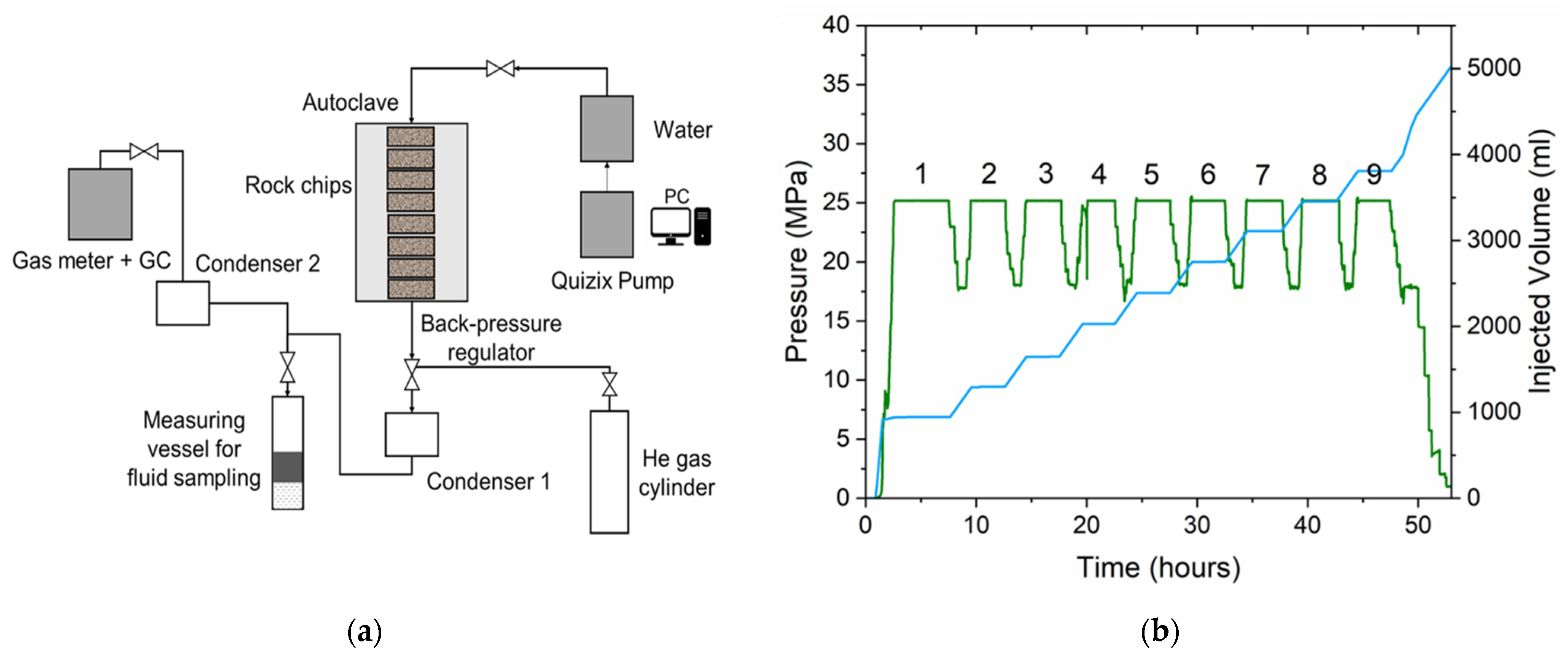
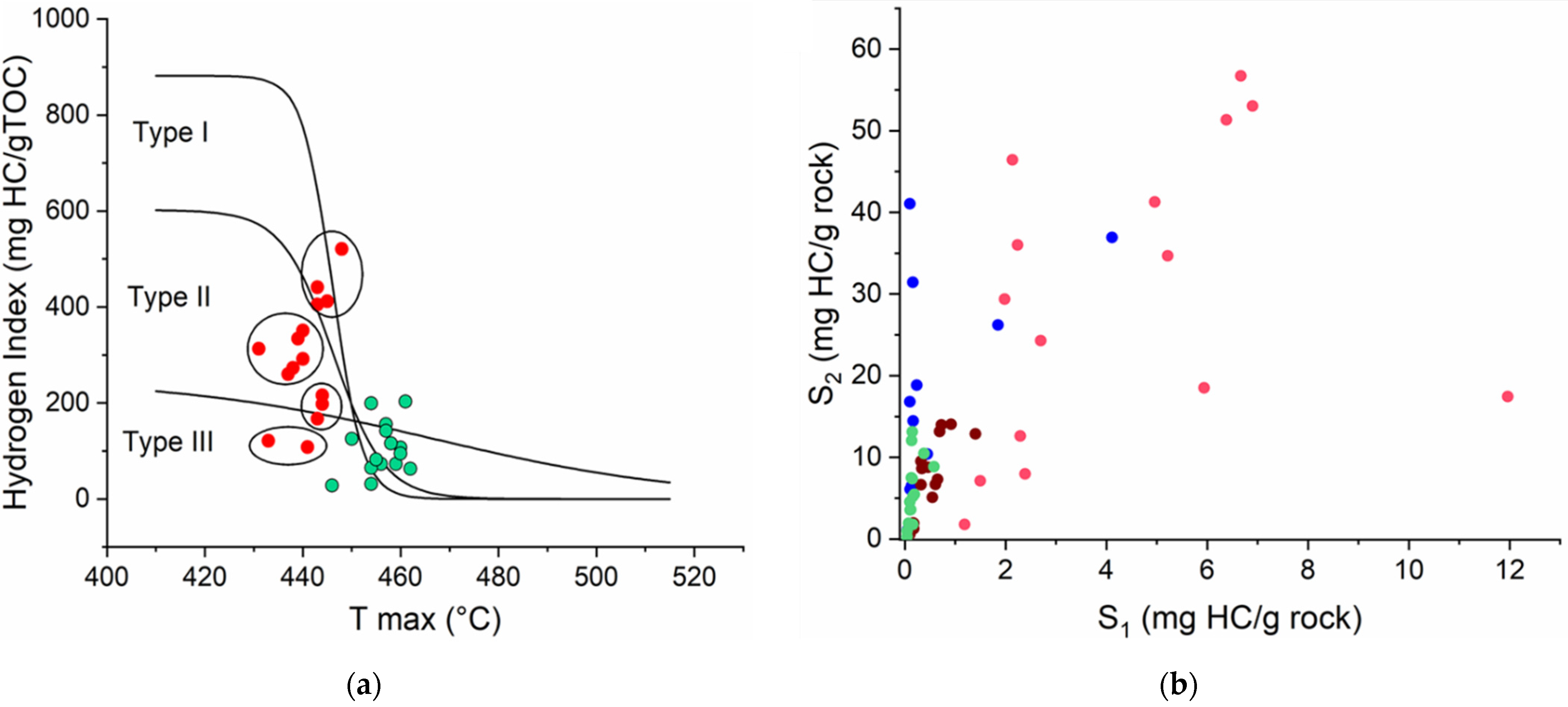
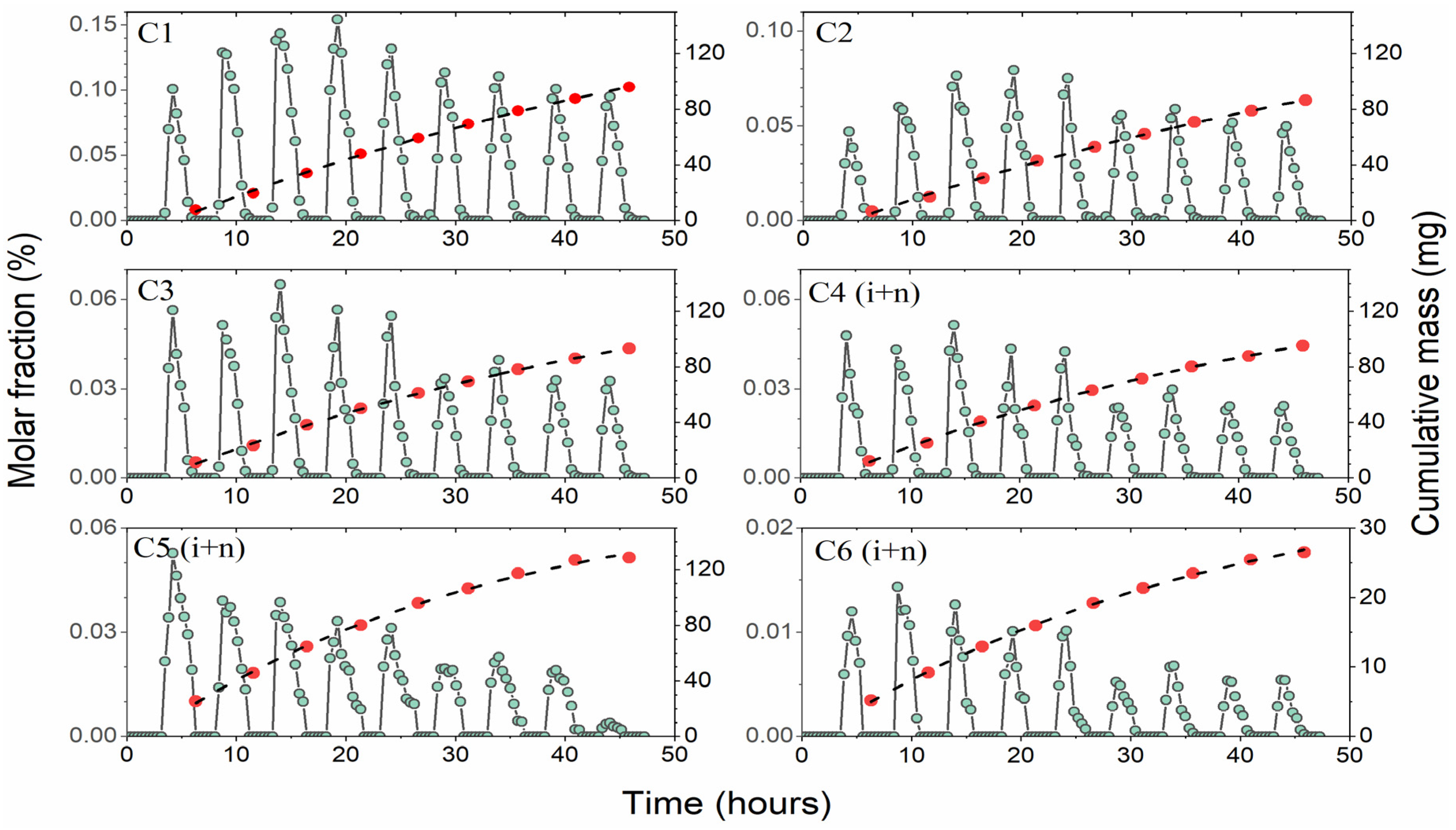
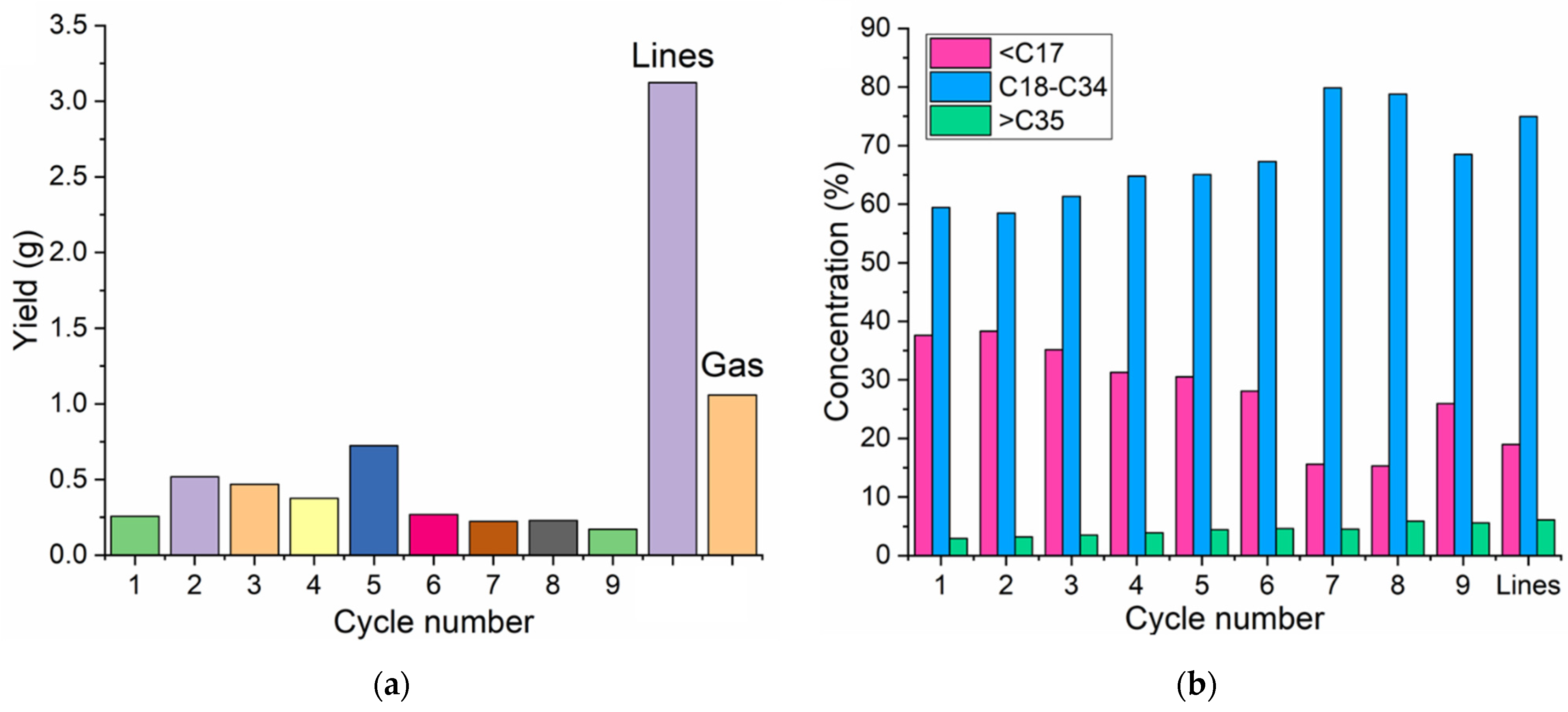
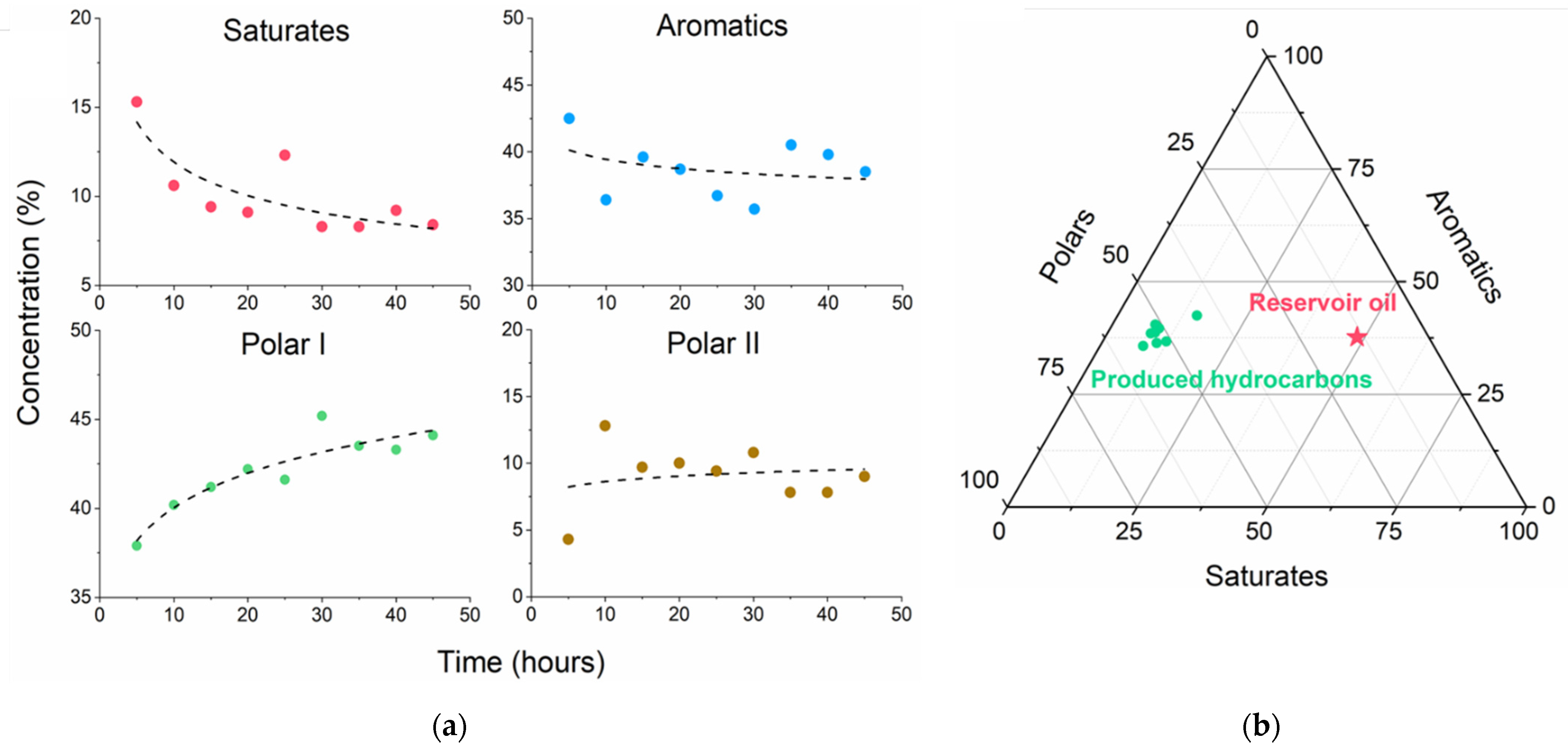
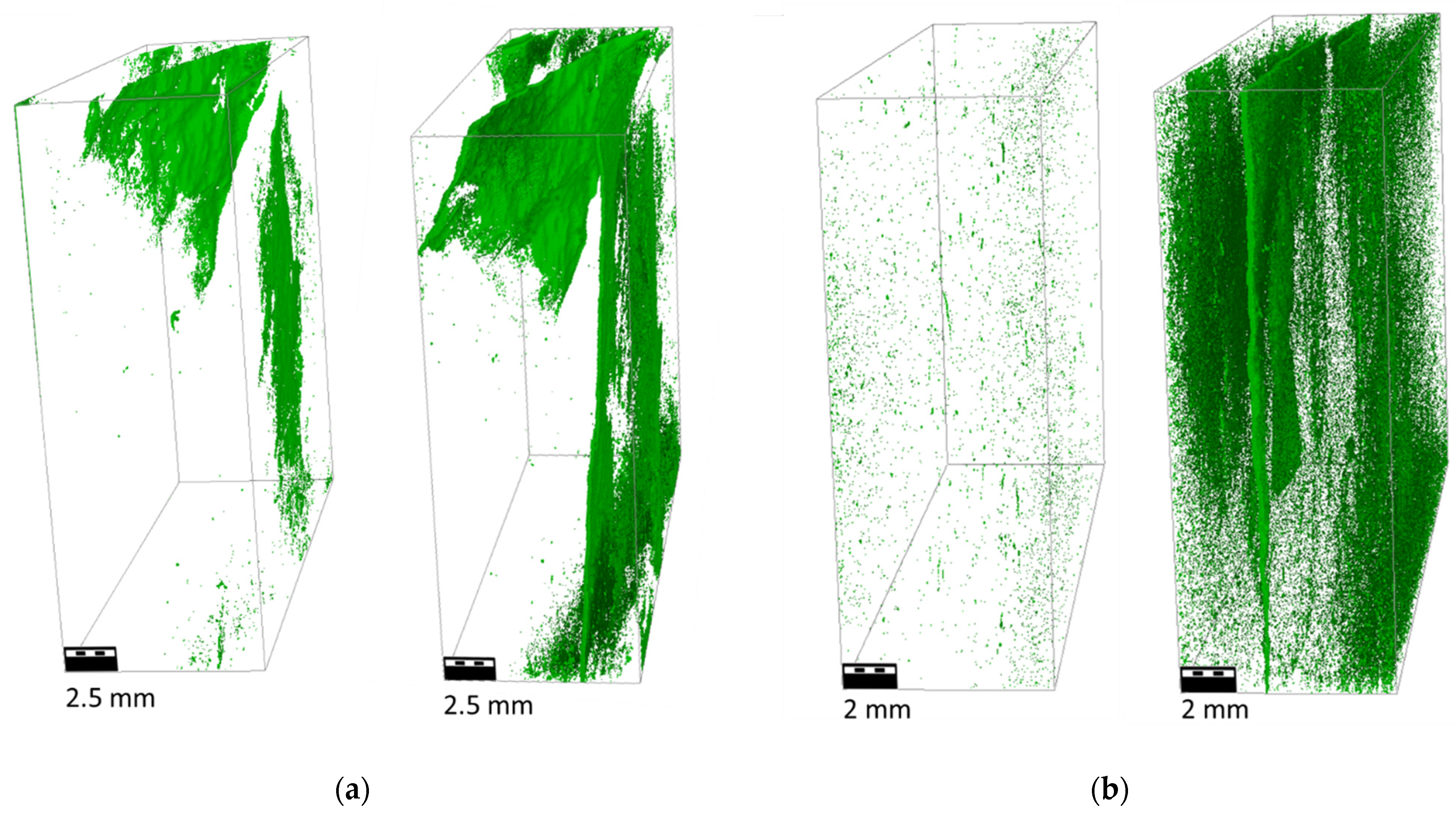
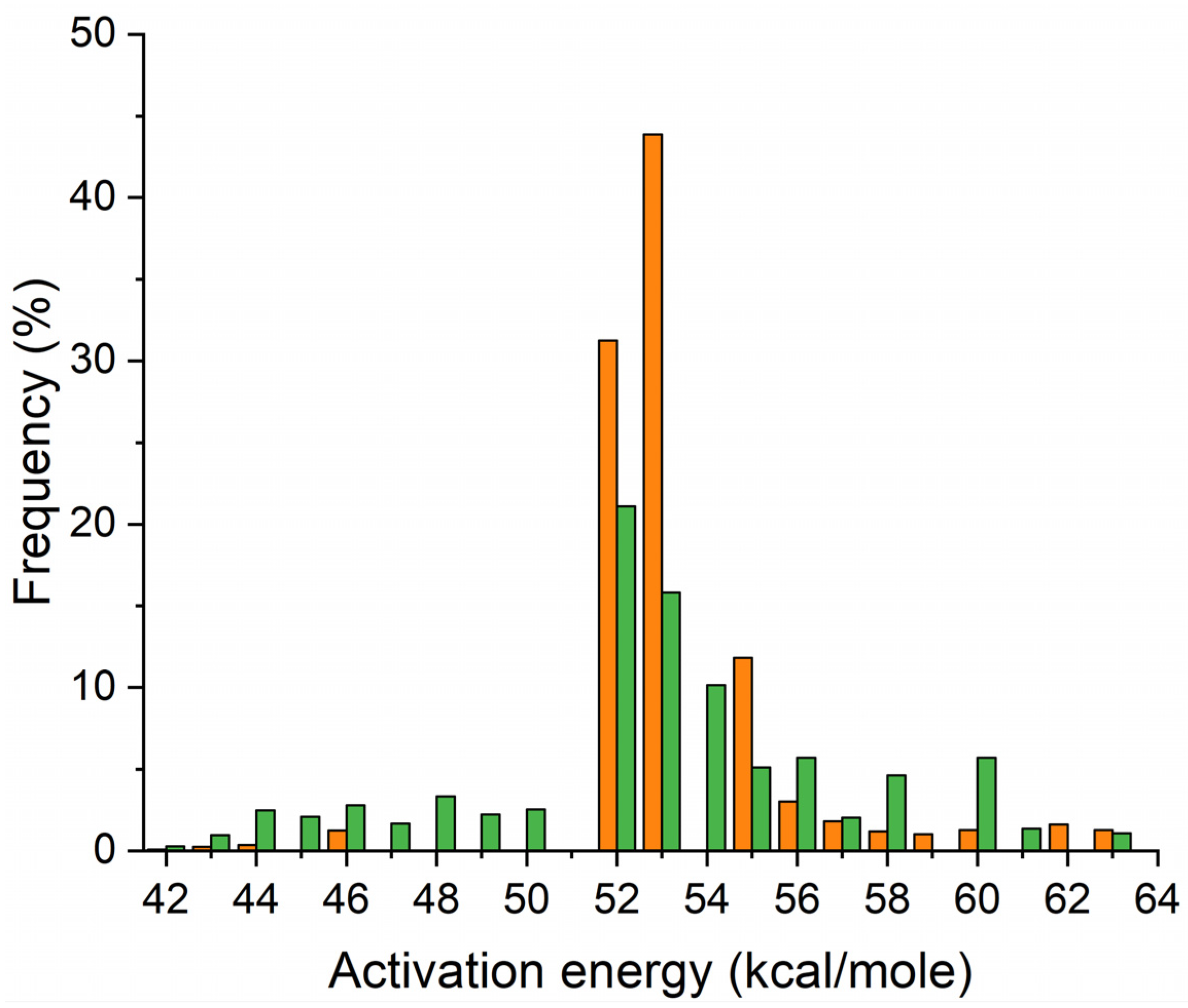
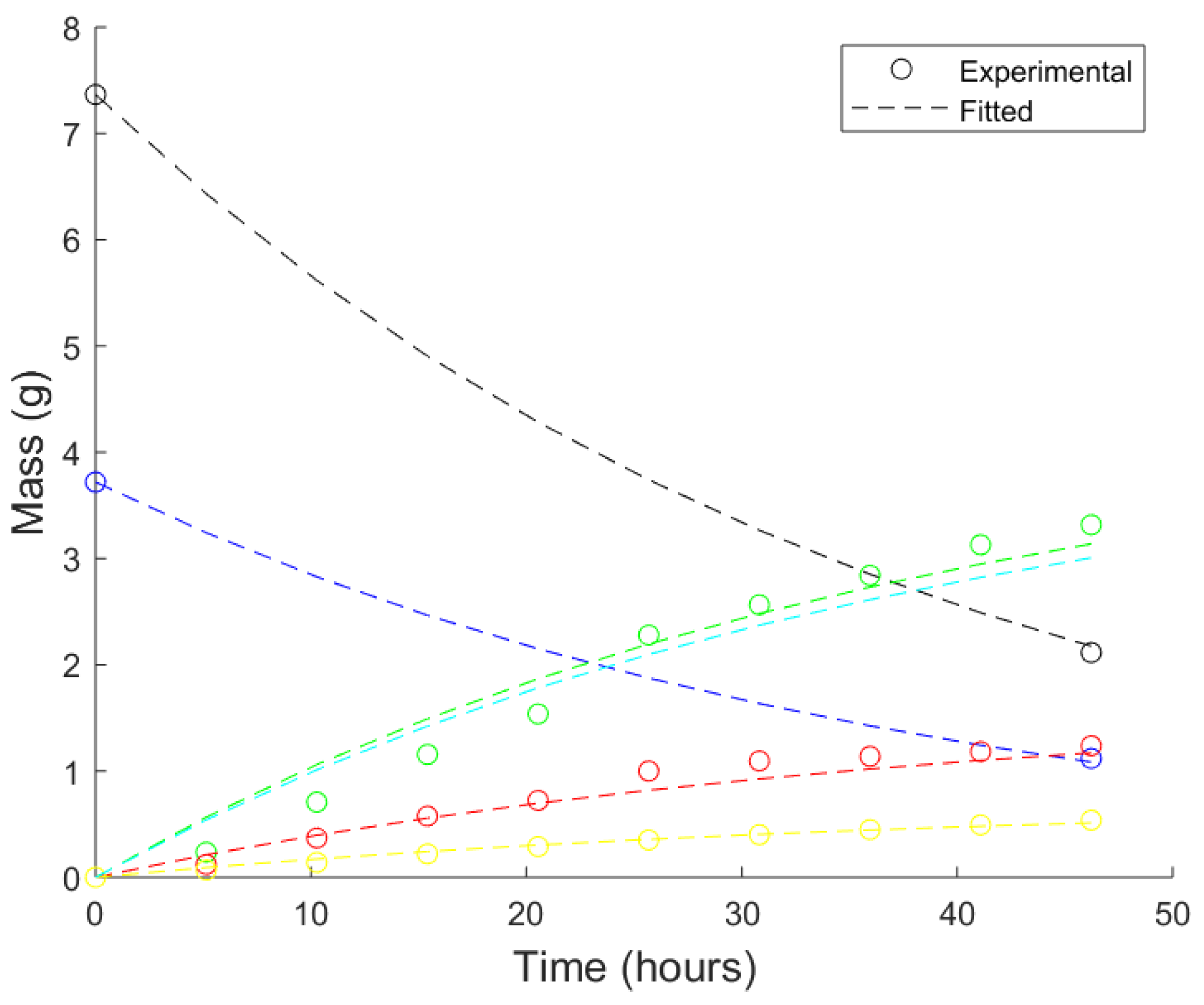
| Sample | Well | S0 (mg/g) | S1 (mg/g) | S2 (mg/g) | S3 (mg/g) | TOC (%) | Tmax (°C) | HI (mg/g TOC) | PI (S1/(S1 + S2)) |
|---|---|---|---|---|---|---|---|---|---|
| BF1 | A | 2.61/0.35 | 4.96/1.40 | 41.26/12.86 | 0.45/0.32 | 14.11/10.21 | 440/450 | 292/125 | 0.107/0.098 |
| BF2 | C | 0.55/0.08 | 11.96/0.18 | 17.42/1.24 | 0.85/0.32 | 5.56/1.68 | 431/459 | 313/73 | 0.407/0.13 |
| BF3 | A | 1.78/0.19 | 5.94/0.55 | 18.5/5.09 | 0.77/0.39 | 7.11/6.96 | 437/456 | 260/73 | 0.243/0.098 |
| BF4 | A | 1.96/0.21 | 5.22/0.65 | 34.69/7.31 | 1.00/0.45 | 12.66/11.1 | 438/454 | 273/65 | 0.131/0.082 |
| BF5 | A | 0.15/0.04 | 1.19/0.10 | 1.77/0.57 | 0.55/0.25 | 1.82/1.63 | 441/454 | 108/31 | 0.401/0.145 |
| BF6 | C | 1.15/0.05 | 2.70/0.32 | 24.28/6.65 | 0.62/0.48 | 11.23/8.03 | 444/455 | 216/82 | 0.1/0.046 |
| BF7 | B | 2.52/0.24 | 6.67/0.73 | 56.7/13.96 | 0.57/0.32 | 12.85/8.9 | 443/457 | 441/156 | 0.105/0.05 |
| BF8 | B | 2.45/0.16 | 6.38/0.69 | 51.33/13.14 | 0.36/0.31 | 12.66/6.45 | 443/460 | 405/203 | 0.111/0.05 |
| BF9 | B | 2.49/0.36 | 6.90/0.92 | 53.02/14.04 | 0.52/0.34 | 12.84/9.85 | 445/457 | 412/142 | 0.115/0.062 |
| BF10 | A | 0.83/0.05 | 2.14/0.32 | 46.43/9.52 | 0.37/0.32 | 8.91/4.78 | 448/454 | 521/199 | 0.044/0.033 |
| BF11 | A | 0.63/0.06 | 2.39/0.18 | 7.95/1.92 | 0.67/0.24 | 6.83/6.54 | 433/446 | 121/28 | 0.231/0.084 |
| BF12 | B | 0.88/0.09 | 2.24/0.34 | 36.01/8.63 | 0.49/0.29 | 10.23/8.03 | 440/460 | 351/107 | 0.059/0.038 |
| BF13 | B | 0.92/0.1 | 1.98/0.46 | 29.38/8.79 | 0.42/0.24 | 8.79/7.56 | 439/458 | 334/116 | 0.063/0.05 |
| BF14 | A | 0.66/0.02 | 1.50/0.17 | 7.12/1.94 | 0.48/0.38 | 4.26/3.07 | 443/462 | 167/63 | 0.174/0.08 |
| BF15 | A | 1.23/0.1 | 2.29/0.61 | 12.6/6.66 | 0.57/0.35 | 6.99/6.33 | 444/460 | 198/95 | 0.154/0.084 |
| Sample | Produced Hydrocarbons, g | Hydrocarbons in the Rock, g | |||||
|---|---|---|---|---|---|---|---|
| HCG | LO | HO | S0 (HCG) | S1 (LO + HO) | S2a (B) | S2b (K) | |
| before | - | - | - | 0.581 | 2.024 | 3.719 | 7.366 |
| cycle 1 | 0.068 | 0.096 | 0.159 | - | - | - | - |
| cycle 2 | 0.140 | 0.295 | 0.479 | - | - | - | - |
| cycle 3 | 0.221 | 0.459 | 0.782 | - | - | - | - |
| cycle 4 | 0.289 | 0.577 | 1.040 | - | - | - | - |
| cycle 5 | 0.352 | 0.798 | 1.543 | - | - | - | - |
| cycle 6 | 0.400 | 0.873 | 1.735 | - | - | - | - |
| cycle 7 | 0.449 | 0.908 | 1.923 | - | - | - | - |
| cycle 8 | 0.493 | 0.943 | 2.118 | - | - | - | - |
| cycle 9 | 0.526 | 0.987 | 2.245 | - | - | - | - |
| after | 0.532 | 0.592 | 2.531 | 0.061 | 0.223 | 0.719 | 2.115 |
| Reaction | Stoichiometry Coefficient | Activation Energy, kcal/mol | Frequency Factor, s−1 | |||
|---|---|---|---|---|---|---|
| 1 | 1.876 | 1.909 | 2.225 | 58.881 | 53.9 | 1014 |
| 2 | 0.657 | 0.668 | 0.779 | 20.609 | 54.3 | 1014 |
| 3 | 0.684 | 0.798 | 21.101 | - | 60.5 | 1014 |
| 4 | 0.390 | 10.332 | - | - | 61.1 | 1014 |
| K | B | HO | LO | HCG | CHAR |
|---|---|---|---|---|---|
| 2000 | 700 | 428.6 | 157.2 | 58.6 | 13 |
Publisher’s Note: MDPI stays neutral with regard to jurisdictional claims in published maps and institutional affiliations. |
© 2021 by the authors. Licensee MDPI, Basel, Switzerland. This article is an open access article distributed under the terms and conditions of the Creative Commons Attribution (CC BY) license (https://creativecommons.org/licenses/by/4.0/).
Share and Cite
Turakhanov, A.; Tsyshkova, A.; Mukhina, E.; Popov, E.; Kalacheva, D.; Dvoretskaya, E.; Kasyanenko, A.; Prochukhan, K.; Cheremisin, A. Cyclic Subcritical Water Injection into Bazhenov Oil Shale: Geochemical and Petrophysical Properties Evolution Due to Hydrothermal Exposure. Energies 2021, 14, 4570. https://doi.org/10.3390/en14154570
Turakhanov A, Tsyshkova A, Mukhina E, Popov E, Kalacheva D, Dvoretskaya E, Kasyanenko A, Prochukhan K, Cheremisin A. Cyclic Subcritical Water Injection into Bazhenov Oil Shale: Geochemical and Petrophysical Properties Evolution Due to Hydrothermal Exposure. Energies. 2021; 14(15):4570. https://doi.org/10.3390/en14154570
Chicago/Turabian StyleTurakhanov, Aman, Albina Tsyshkova, Elena Mukhina, Evgeny Popov, Darya Kalacheva, Ekaterina Dvoretskaya, Anton Kasyanenko, Konstantin Prochukhan, and Alexey Cheremisin. 2021. "Cyclic Subcritical Water Injection into Bazhenov Oil Shale: Geochemical and Petrophysical Properties Evolution Due to Hydrothermal Exposure" Energies 14, no. 15: 4570. https://doi.org/10.3390/en14154570
APA StyleTurakhanov, A., Tsyshkova, A., Mukhina, E., Popov, E., Kalacheva, D., Dvoretskaya, E., Kasyanenko, A., Prochukhan, K., & Cheremisin, A. (2021). Cyclic Subcritical Water Injection into Bazhenov Oil Shale: Geochemical and Petrophysical Properties Evolution Due to Hydrothermal Exposure. Energies, 14(15), 4570. https://doi.org/10.3390/en14154570








